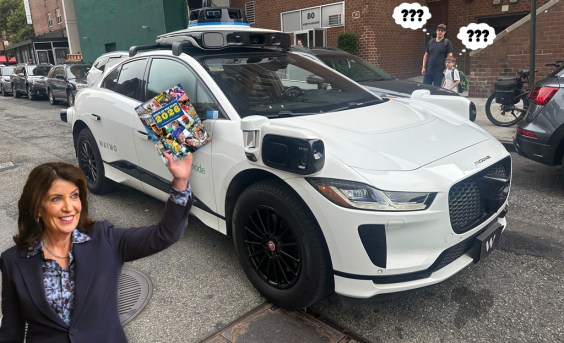 Deputy Mayor Linda Gibbs. Photo: City Hall News
Deputy Mayor Linda Gibbs. Photo: City Hall NewsWhile receiving an honor from AARP last night, Mayor Michael Bloomberg and City Council Speaker Christine Quinn reiterated their support for the Age-Friendly New York City plan to make the city work better for senior citizens. Because New York's elderly pedestrians are at the greatest risk from motor vehicles, the Age-Friendly New York program includes a number of pedestrian safety components. Though Bloomberg and Quinn reiterated their support for these programs last night, perhaps the most enthusiasm for redesigning streets to better serve older New Yorkers came from Linda Gibbs, deputy mayor for health and human services.
The Age-Friendly New York City agenda includes 59 initiatives meant to make it easier to age in the city, including building traffic calming public spaces and redesigning the city's most dangerous intersections. Bloomberg's remarks didn't specifically mention the pedestrian safety aspects of the plan, but he did reaffirm his commitment to follow through on the entire Age-Friendly program. "When we take on a project," he said, "we actually do it."
Quinn focused more closely on street redesigns. "Through complete streets, we're making New York a place that's safe in every way for seniors," she told the audience. In April, Quinn stood with AARP in front of the Ninth Avenue protected bike lane to participate in a safety audit. Discussing that experience last night, Quinn said that the redesigns of Eighth and Ninth had helped fix "two very problematic corners" at 23rd Street.
Perhaps most striking, it seems that livable streets advocates have a potential ally in Deputy Mayor Gibbs, who oversees the Age-Friendly New York City program. Discussing NYCDOT's Safe Routes for Seniors program, Gibbs had particular praise for neckdowns at dangerous intersections. "It creates an intentional bottleneck that not only makes the distance shorter, but slows down the traffic as it approaches the intersection," she said, "so you have a double benefit."
To keep seniors safe, one area that would especially benefit from Gibbs' influence is Manhattan's East Side.
The wide avenues there remain particularly dangerous for older pedestrians: AARP called attention to the problem in January, and Yorkville is targeted for a Safe Routes for Seniors treatment. While the original plans for re-designing First and Second Avenues included pedestrian refuge islands, which are of particular benefit to older New Yorkers, along most of the corridor south of 125th Street, as of this month the administration will only fully commit to pedestrian safety improvements south of 34th Street.
When asked whether she'd support restoring refuge islands to the full extent of the original plan, Gibbs said she just didn't know that level of detail about the First and Second Avenue redesign, which isn't under her direct supervision. The original plan earned the support of community boards and elected officials representing the length of Manhattan, and more importantly, would save seniors' lives in East Harlem, the Upper East Side, and Midtown. It's an essential, and shovel-ready, way to make good on the promises of Age-Friendly New York City.





